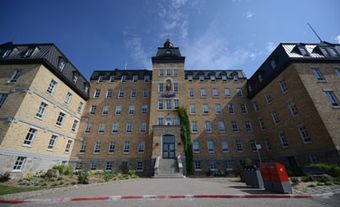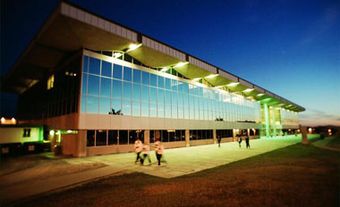
University of Alberta
The University of Alberta, in Edmonton, is one of Canada's largest research universities. It was established in 1908 with Henry Marshall Tory as its first president. Classes began in September of that year with 45 students and five faculty. President Tory envisioned a secular university with a mission to educate everyone in the province; as he put it, "The uplifting of the whole people shall be its final goal." The University Act, drafted by Tory, specifically prohibited offering any courses or programs not open to women, and a woman named Decima Robinson became the university's first graduate in 1912. The university grew rapidly up to 1914, adding faculties of Law (1912), Medicine (1913) and Applied Science (Engineering, 1913).
The Department of Extension (1912) quickly began offering lectures and library services across the province. The department later created two enduring Alberta institutions, CKUA radio (1927) and the Banff School of Fine Arts (1933, now the Banff Centre). The years after the end of the Second World War saw very rapid growth, as did the decade of the 1960s.
The university has had affiliations with several religiously based post-secondary institutions over the years: St. Stephen's College (Methodist/United Church), St. Joseph's College (Roman Catholic), Concordia University College (Lutheran), King's College (interdenominational). Campus Saint-Jean, which began in 1910 as a Juniorate of the Oblate Order with connections to the University of Ottawa, became part of U of A in 1963 and now offers baccalaureate and some masters programs in French. In 2004 the university took over Camrose Lutheran College, which became Augustana Campus in that city. U of A established branches in Calgary and Lethbridge in the 1950s, which became independent universities in 1966 and 1967 respectively.
The U of A offers more than 200 undergraduate programs and approximately 170 graduate programs in some 275 research areas. The Faculty of Extension, a Canadian leader for more than a century, specializes in continuing education, study tours and ESL (English as a second language) classes. The university offers programs of study in Cortona, Italy and in France. The Faculty of Native Studies provides undergraduate, graduate and certificate programs addressing issues of language, culture, land and resources, and self governance.
The U of A has more than 100 research centres and institutes on campus, including the National Institute for Nanotechnology, a joint venture with the National Research Council of Canada. U of A is a partner with other universities in a number of research centres, notably the Bamfield Marine Science Centre and TRIUMF, the National Laboratory for Particle and Nuclear Physics. Agricultural and environmental research takes place at ten centres around Alberta, including the Devonian Botanic Gardens and two 5000 hectare ranches.
Physics professor and later Dean of Engineering Robert Boyle led a team which developed the first workable sonar for the Royal Navy in 1918. J.B. Collip, Professor of Biochemistry in the 1920s, played a crucial role in the discovery of insulin and began a tradition of diabetes research that continues to the present at the U of A with the development of the Edmonton Protocol for pancreatic islet transplants. Engineering professor Karl Clark worked out the basic process for separating petroleum from the Athabasca oil sands in the mid-1920s. Chemist R.U. Lemieux was the first to synthesize sucrose in 1953.
The U of A leads the country in the number of professors (31 since 1986) who have received 3M Teaching Fellowships, Canada's top award for university teaching excellence. University staff and students, especially in the Faculty of Medicine, receive extensive support from the Alberta Heritage Foundation for Medical Research. University personnel also collaborate closely with members of the Alberta Research Council (housed and managed by the university from 1921-1942) and the Alberta Oil Sands Technology and Research Authority. Microelectronics and the application of advanced laser technology are primary areas of research in the Alberta Microelectronic Centre and the Alberta Laser Institute.
Noted Canadian composers Violet Archer and Malcolm Forstyth taught in the Music Department at U of A for many years. The department also provides a home, in collaboration with the Smithsonian Institution, for the Folkways recording collection. The university was the first in the British Commonwealth to establish a PhD program in physical education. In collaboration with the City of Edmonton, U of A hosted the World University Games, second in size only to the Olympics, in 1983. The Canadian Institute of Ukrainian Studies is one of the leading research centres on Ukraine. It publishes the Journal of Ukrainian Studies and has published more than 160 books since its founding in 1976.
The University of Alberta Press (est 1969) publishes approximately 12 books per year. The University Library contains the second largest collection in Canada, with approximately 13 million titles. It is a leader in the development of access to electronic resources with websites such as Peel's Prairie Provinces and the Alberta Folklore and Local History Collection. The university's main campus (North Campus) on the North Saskatchewan River in central Edmonton is 89 ha in extent. In addition to Campus Saint-Jean and Augustana the university has a city centre campus (Enterprise Square) and sports, agriculture and residence facilities on its South Campus. The university is the fifth largest employer in the Edmonton area.
Distinguished alumni include Dr. George Stanley, designer of Canada's maple leaf flag; Governor General Roland Michener; Prime Minister Joe Clark; Supreme Court Chief Justice Beverly McLachlin and Nobel Prize winning physicist Richard Taylor.
The U of A's colours are green and gold and its motto is Quaecumque Vera (Whatsoever things are true). It has approximately 31 000 undergraduate and 7000 graduate students.

 Share on Facebook
Share on Facebook Share on X
Share on X Share by Email
Share by Email Share on Google Classroom
Share on Google Classroom


